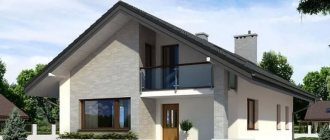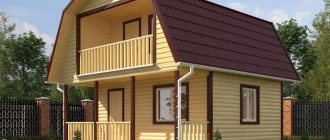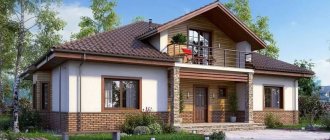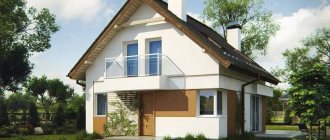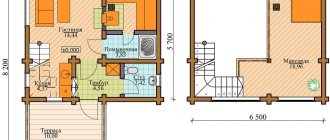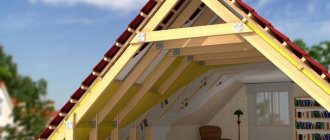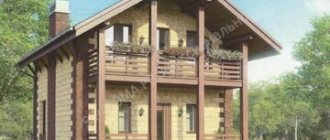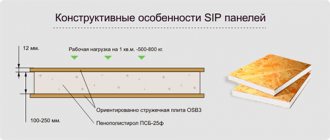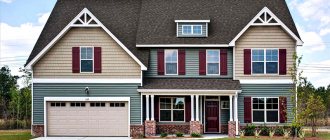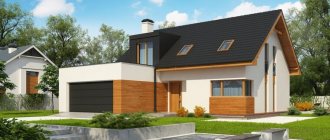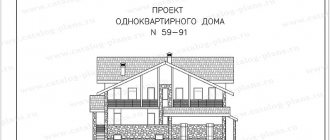A house measuring 10 by 12 meters is the best option for country housing. It takes up very little space on the site - a little more than a hundred square meters, and its usable area is more than 100 square meters. meters. And this is in a one-story version. If you build a 10 by 12 house with an attic, it will comfortably accommodate a larger family. For large families, compact cottages with a full second floor are ideal, but the well-implemented ideas for decorating the attic from the previous version should not be discounted.
House layout 10 by 12 Source roof-tops.ru
House layout options 10 by 12
The layout of the cottage depends on the type of building. It can be one-story, two-story, attic, basement, etc. In any case, the following premises should be planned in it:
- hallway;
- living room;
- kitchen;
- dining room;
- technical premises;
- bedrooms;
- bathrooms.
The guest area, including an entrance hall, living room, dining room and kitchen, can be designed as a single room. Some projects provide for a separate isolated kitchen. The dining room can be placed as part of the living room or kitchen.
The number of bathrooms depends on the number of floors of the cottage and its architectural design. In most cases, the layout of a 10 by 12 house is designed taking into account saving internal space. Therefore, they usually have as many bathrooms as there are floors. Sometimes a small bathroom for guests is provided in the guest area.
The number and composition of technical premises differs in different design solutions. You can choose a house project with a garage and a workshop, or, for example, with a separate laundry room.
Layout of a three-bedroom house Source mr-shkaff.ru
Length 4 driveway house. Typical series of Khrushchev buildings. Photos of layouts
Since 1957, after the adoption of a law that provided for the elimination of excesses in the design of houses, buildings of a new type began to be erected in the USSR. Popularly, such houses were called “Khrushchevka” (derived from the name of the General Secretary of the CPSU Central Committee N.S. Khrushchev). Such houses received a second name - Khrushcheby, mainly because of the inconvenient and disproportionate layout of the rooms, narrow corridors and landings, thin walls and, as a result, terrible sound insulation. In this article we will talk about what the typical Khrushchev series are, and we will try to highlight the main pros and cons of these buildings. We will provide the planning features in the form of descriptions and photos.
Typical series of Khrushchev buildings: the main pros and cons of houses
Let's look at the main characteristics of the apartments and determine the features of each series of Khrushchev buildings that were built over the course of 27 years. It is worth noting that initially the Khrushchev buildings were intended to be used as temporary housing and the operational life of the building ranged from 25 to 50 years. But, as you know, people still live in such houses in our time. The disadvantages of Khrushchev-era apartments include poor sound insulation and thermal insulation (it’s cool in the winter, and too hot in the apartment in the summer), not always a good layout of the apartment and entrance: narrow corridors, small kitchen, lack of a garbage chute and, very often, an elevator. The main advantages of such houses include their low cost.
The main advantages of such houses include the low cost of housing and developed infrastructure around the building. As a rule, not far from Khrushchev buildings there are kindergartens, schools, shops and excellent transport interchanges. If you don’t have enough money to buy an apartment, then this is not the worst option. Moreover, such buildings in Moscow and other Russian cities are subject to demolition, in which case the owners receive brand new housing, or reconstruction and redevelopment.
Series 1-464 (1960 – 1967)
General drawing:
One of the most popular series of Khrushchev buildings in the USSR was 1-464 (1960 - 1967). This is a panel house with 5 floors; it is rare to see 3 and 4 floor buildings. All apartments have balconies (also additional storage rooms), but there are no elevators and residents of the building have to go up and down the stairs, which is quite difficult for elderly people and families with small children. The bathrooms in the apartments are combined, there is no common garbage chute in the entrance, and the number of apartments on the site is 4. The height of the ceilings in the apartments is 2.5 m2, the kitchens are less than 6 m2, to be more precise - 5.8 m2. Apartments 1, 2 and 3 rooms.
Picture – drawing:
1 room:
2 room:
3 room:
Series 1-335 (1963 – 1967)
From 1963 to 1967 The territory was built up with houses of the 1-335 series. These are also panel buildings, with a ceiling height of 2.54 m, balconies in each apartment, shared bathrooms, and the absence of an elevator and garbage chute. The kitchen area is slightly larger than in the previous series - 6.2 m2, the ceiling area is 2.5 m. There are four apartments on the site - from 1 to 3 rooms. In addition to balconies, the apartments have additional storage rooms and built-in wardrobes.
1 room:
2 room:
Series 1-434 (1958 – 1964)
This series was built from 1958 to 1964; in different years of construction, the layout of the apartments was slightly modified. So, for example, in buildings of 1958 in one-room apartments the living room area was 18.6 m2, and in 1959 it decreased to 18.2 m2, in 1969 the room area was 17.7 m2. And so, in all types of apartments, the area of residential premises varied in the direction of decrease and increase. But the kitchen area remained unchanged - 5.8 m2, as well as the ceiling height - 2.5 m. The houses are brick, with combined bathrooms, and each apartment has a balcony, pantry and built-in wardrobes.
One or two floors
All the premises necessary for a small family to live can be placed in a one-story building 10 by 12. Houses on one level have their advantages:
- light weight of the building structure, which allows the use of inexpensive foundations;
- absence of expensive interfloor coverings;
- lack of stairs that take up space in the house.
There is another advantage of a 10 by 12 one-story house project. If you choose to develop a cottage with an attic, then, if necessary, you can convert it into a residential attic, and thus increase the living space.
If you need housing for a family of 4 or more people, you should immediately consider the option of a two-story building, and choose between an attic cottage and a building with two full floors. Advantages of attic houses:
- cost-effectiveness of construction;
- a more elegant and attractive silhouette of the house;
- the ability to create original interiors in the attic.
Cottages with two full floors also have their advantages. They are preferred in such cases:
- if you need to maximize the area of a small house;
- if the owners prefer a classic style in architecture;
- if the house is being built in a region with a harsh climate, where additional thermal insulation of the walls is necessary;
- if the owners do not want to solve the problems of decorating non-standard attic rooms.
One-story house 10 by 12 Source almazgarant.ru
The height of a five-story building. Why were houses built with 5 and 9 floors in the USSR?
Probably many people wondered why in Soviet times, starting from the post-war 50-60s. In large cities, were nine-story and five-story buildings built?
House series 1-335 in Moscow (5th Sokolinaya Gora Street)
As for the five-story houses, the so-called “Khrushchev” buildings, firstly, the main goal during their construction was the rapid creation of cheap housing in order to speed up the resettlement of village residents to cities (1957-1985). By the way, one of the authors of the project was Vitaly Lagutenko, the grandfather of the lead singer of the Mumiy Troll group. He created design documentation for the French five-story project, and the Soviet Union bought a license for the mass production of concrete products from the French creator of panel houses, Raymond Camus.
Soviet construction, second half of the 20th century.
As a result, Khrushchev chose this particular project, the cheapest in construction, the K-7 (frame) project. Such a house was built in parallel with the work of electricians, painters, plasterers and plumbers, who worked in three shifts. It took only 12 days to create a house; 402 factories and two hundred testing sites were built in the country. Five floors was the maximum possible construction of a house without an elevator and a garbage chute from the point of view of French builders, which further reduced the cost and accelerated the construction of an already not particularly expensive product. Houses were built in entire microdistricts, in which sewerage, heating and water were centralized - an attic and basement were not needed, which was also a plus for saving money. In cities with a population of less than half a million, such houses were built en masse.
House series K-7 in Kuzminki on the street. March. Chukova
In larger cities, nine-story houses began to be built. There are a number of reasons why this number of storeys was chosen.
One of the main reasons was that the height of a standard mechanized fire truck ladder was 28 meters. It turned out that the stairs could only reach the ninth floor, for evacuating people in case of fire. The floors above required an H1 standard fire escape (entrance is through an open space outside the building). There are also standards H2 and H3, which already imply special staircases, for which the house must have special zones, which will ultimately lead to high construction costs and may be acceptable in high-rise buildings of 14-20 floors.
House series I-515/9sh with 4 entrances after renovation in Moscow, built in 1969
Another reason was the standards of the Soviet GOST. According to these requirements, if one elevator was required for a 9-story building, then for ten floors there are already two, one of which must be cargo, in addition, a smoke removal system, air pressure and special escape routes must be installed. In the same subsequently built 12-story buildings in large Soviet cities, the cost per square meter was significantly higher than in nine-story buildings - this also contradicted the main goal, the construction of budget housing without architectural delights and in the shortest possible time.
Some regions of the Soviet Union were located in earthquake-prone regions, where building above nine floors was prohibited by regulations. Often, projects created under these conditions were launched in safe regions, so as not to waste time on studying and approving whether it is seismically dangerous or not.
The construction of houses higher than nine floors meant a refusal to use gas and an additional load on the electrical grid. The main tower cranes were standardly assembled for the construction of houses of nine floors, although the height of the crane could be changed using mounted sections, but such changes had to go through inspection and a lot of “bureaucratic” paperwork, which was clearly not in favor of a “crash course” in the construction of mass housing . Although houses with higher heights were built, they were not as widespread as 5- and 9-story ones, and besides, these were mainly the largest cities in the country - Moscow, Kyiv and Leningrad.
Rational layout of a compact house
Modern architects use proven and reliable techniques for saving interior living space. First of all, designers strive to use as few internal partitions as possible. This applies to the daytime zone. So, when combining a living room, kitchen and dining room, you can get one spacious, bright and very comfortable room. It can be visually divided into different functional territories. For this, bar counters, differences in floor and ceiling levels, sliding screens, low partitions, etc. are used.
Another effective technique is the combination of technical rooms. For example, a boiler room can be combined with a pantry or vestibule.
There should be a minimum of corridors and transitions. The best way to ensure communication between rooms is to design one spacious hall, from which you can go to any room on the floor.
Layout of a house with a hall in the center Source retrolot.ru
See also: Catalog of 10 by 12 house projects presented at the Low-Rise Country exhibition.
The length of the five-story building is 4 entrances. Khrushchev buildings: description, typical layouts with photos
Introduction
Today there are many multi-storey houses of various layouts, years of construction and living space sizes. In this article, we will take a closer look at the basic layouts of the popular multi-story “Khrushchev” buildings, which can be found in every country of the former USSR. As a rule, these are 4 or 5-story apartment buildings that were built during the leadership of Nikita Sergeevich Khrushchev.
“Khrushchev apartments” were built from 1958 to 1985, while the construction was of a modern type at that time, and thousands of families were able to get comfortable apartments with walk-through rooms. Since 1958, its own SNiP has been in force.
General information about Khrushchev buildings
The first generation of 4- or 5-story “Khrushchev” buildings were distinguished by a small living area and walk-through rooms. In such apartments, the ceiling height reached only 2.48 meters; in block-type houses, the ceiling height could reach 2.7 meters. The Khrushchev apartments had rather weak soundproofing of the premises, a shared bathroom and no elevators.
It is worth noting that some “Khrushchev” buildings were temporary housing, which were expected to last up to 25 years. However, most of them are still used by citizens of former USSR countries. Other operational standards were applied to “Khrushchev” buildings of the non-demolished series for up to 50 years. Subsequently, experts stated that the operational period can be extended to 150 years (in case of major repairs in accordance with the standards). Today, “Khrushchev” buildings in Moscow and St. Petersburg are subject to demolition. However, in Minsk, the “Khrushchevites” were given a cap. repairs and insulation of external walls.
Main characteristics of "Khrushchev":
- 3-room apartments with a total area of 55-58 m²;
- 2-room apartments with a total area of 30-46 m²;
- 1-room apartments with a total area of 31-33 m².
Living area of rooms:
- Living rooms – from 14 m²;
- Bedrooms – from 8 m²;
- Children's rooms – from 6 m²;
- Kitchens – from 4.5 m².
Types of standard layouts, series, photos, descriptions and years of construction of Khrushchev houses
SERIES 1-464 – (year of construction 1960-1967)
Five-tier panel houses with four apartments on one site.
Peculiarities:
The height of the premises is 2.5 m;
Combined bathroom;
Kitchen – 5.8 m²;
Features: storage room, built-in wardrobes, balcony.
The living room area in 1-room “Khrushchev” apartments of this type is 19 m², in 2- and 3-room apartments it is 17.3 m²; 19 m² and 20.4 m² depending on the layout. The storage room is located at the end of the bedroom or between the 1st and 2nd bedrooms. Exit to the balcony from the living room. Bathroom combined next to the kitchen.
SERIES 1-335 – (year of construction 1963-1967)
Five-tier panel houses with four apartments on one site.
Peculiarities:
The height of the premises is 2.5 m;
Combined bathroom;
Kitchen – 6.2 m²;
Features: storage room, built-in wardrobes, balcony.
The living room area in 1-room “Khrushchev” apartments of this type is 18 m², in 2- and 3-room apartments it is 17.1 m²; 18.2 m² and 19.1 m² depending on the layout. The storage room is located at the end of the living room or between the 1st and 2nd bedrooms. Exit to the balcony from the living room. Bathroom combined next to the kitchen.
SERIES 1-434 – (year of construction 1958-1964)
Five-tier panel houses with four apartments on one site.
House with a basement
The basement floor allows you to expand the space of the house, but requires high-quality waterproofing and strengthening of the basement walls. A 10x12 two-story house design can consist of one above-ground and one underground level. Arranging a basement during construction is quite expensive, but it can house all the technical rooms, including a garage.
If you want to get a house with an expanded layout on a small plot, you can choose a project with living quarters in the basement. In this case, the lower floor should have windows, ventilation and a good insulation system.
Ground floor plan of a small house Source mr-shkaff.ru
How panel housing construction began
A big problem in the post-war years was communal apartments, in which several families lived at once.
The construction department was then tasked with creating a residential building project that would be as budget-friendly as possible and would allow apartments to be occupied by families.
As part of its implementation, the idea of construction based on a load-bearing frame was introduced. In 1951, the first microdistrict was built in the capital using frame-panel technology with ten-story buildings. At the same time, development of frameless houses was carried out, the first of which was built within three years.
In 1955, a truly historic decree was issued by the then communist leader N.S. Khrushchev. It talked about eliminating excesses in building design. The “ostentatious” architecture characteristic of the years of Stalin’s rule no longer corresponded to the party’s ideas about what buildings in the country should look like.
Stalinist architecture fell out of favor under Khrushchev
The party took a new course, the rationale for which boiled down to the following: moving several families into one apartment represents a social problem. Communal apartments are unprofitable housing from an economic point of view.
Builders were given the task of developing projects that, due to their low cost, would help provide housing for workers in a short period of time. It was planned that by 1980 each Soviet family would receive a separate apartment.
This is how the notorious small-sized “Khrushchev” apartments appeared, which to this day make their owners rack their brains over how to expand the space at least a little (see the link for ideas on the layout and design of “Khrushchev” buildings).
Project selection
When choosing a 10 by 12 house project, you need to take into account the main features of private housing. Initially, you need to decide on the material for constructing the walls and roof. Other important factors are the number of bedrooms, bathrooms, and the presence of an attached garage and other additional elements. If the plot has already been purchased, you need to take into account the location of the future house and its orientation to the cardinal points.
House 10 x 12 with attached garage Source stroyportal.ru
Renovated apartments
Renovated apartment:
- Individual design project
- Metal entrance door
- Floor covering: laminate, linoleum, floor tiles, porcelain stoneware - to choose from;
- Skirting boards: plastic skirting boards;
- Interior doors: PVC-coated doors;
- Wall decoration: vinyl wallpaper on non-woven or paper backing;
- Kitchen apron
- Lighting: spotlights, chandeliers;
- Bathroom: wall tiles, floor tiles (ceramic granite), steel or acrylic bathtub according to the customer's size, cabinet with sink, toilet, sink faucet, bathtub faucet, heated towel rail, mirror.
Turnkey renovation work
- Walls: wallpapering all walls except the balcony with preparation (plaster without beacons if necessary, putty)
- Electrical: installation of sockets, switches, internet connection points
- Floors: self-leveling floor (if necessary), linoleum flooring, laying laminate flooring, installation of floor skirting boards
- Doors: installation of an entrance door and three interior doors with handles
- Bathroom: communication lines, wall and ceiling tiles, installation of a bathtub, toilet, washbasin with faucets, bath screen, installation of a heated towel rail
- Ceilings: stretch ceilings - white matte with platforms and holes for chandeliers and lamps
- Kitchen apron according to design project
Individual designer renovation in MORTGAGE:
For a 1-room apartment
- 380,000 rubles
For a 2-room apartment
- 470,000 rubles
Sign up for viewing
What is the best material to build from?
A 10 by 12 house can be built from any building material. The choice depends on the preferences of future homeowners and the operating conditions of the house.
Brick
Traditional ceramic bricks have proven themselves to be excellent. It is reliable and durable. However, it is inferior in some respects to improved ceramics. The price of a turnkey brick cottage 10 by 12 starts from 4.2 million rubles.
Cottage 10 by 12 made of brick Source mr-shkaff.ru
What type of foundation to choose
Main types of foundation:
- tape;
- slab;
- pile;
- columnar;
- floating.
It all depends on the building materials used to build the house and the characteristics of the soil. The strip foundation copes well with heavy loads (heavy walls and floors near the house). This applies to the recessed type of base. A brick or stone house with dimensions of 8 by 8 m can be built on exactly this. A shallow foundation is weaker and is used for the construction of lightweight wooden structures. To a certain extent, a slab foundation is universal. It is applicable to almost all types of soil and at any depth of groundwater. A frame, timber and brick house can be built on such a basis. The costs, however, will be high. It is worth noting the quality of pile foundations. Since this is the most reliable type of foundation, they are used on unstable soil. For the construction of low-rise country houses, foundations on screw piles are often used.
Video description
About the construction of houses according to standard projects in the following video:
Standard ready-made projects are created in a wide variety. No matter how demanding the future homeowner is, he will be able to choose the ideal cottage option for himself. The main thing is to immediately determine the main parameters of the house, and unimportant elements can be adjusted.
Project of a two-story cottage 10x12 Source mr-shkaff.ru
Examples of projects
Projects of 10 by 12 cottages may have various features that should be taken into account when choosing.
Cottage with attic and garage
Option for a country attic house with a built-in garage. This 10 by 12 two-story house plan is suitable for a family with 2 or 3 children. In this project, it is worth paying attention to the fact that the kitchen-dining room is separated from the living room and hall by a partition. This architectural move is not very popular now. Modern studios are often preferred. However, an isolated dining room can become an additional living room, which will allow family members to organize their leisure time without disturbing each other.
House with a built-in garage Source mr-shkaff.ru
House with basement and attic
A three-level cottage offers maximum usable space in a minimum building area. The zoning of the above-ground floors is classic - the first floor is reserved for daytime premises, and the second is the area for the owners' personal premises, although you can often come across other ideas for using the attic. The ground floor has an extended layout. In addition to the garage and technical premises, a gym is designed in it. Instead of a hall, you can equip a billiard room or, for example, a sauna.
Cottage with attic and basement Source mr-shkaff.ru
One-story house project
One-story cottage for a family with two children. A successful 10x12 house project with an excellent layout that involves rational use of every square meter. Thanks to the use of an “open” guest area, the architects managed to fit a garage with an additional room, a double buffer zone in the form of a vestibule and hallway, 2 bathrooms and 3 comfortable bedrooms into the space of a small house.
Project of a compact country house Source yandex.by
House project for a small family
A project in which you can see that a family of 2 or 3 people in a 10 by 12 house can live with increased comfort. There is a wide terrace facing the backyard, as well as a small winter garden and a guest room. The kitchen-dining room is conventionally separated from the living room by a fireplace.
House project 10 by 12 with a terrace Source mr-shkaff.ru
Let's continue the rental topic, but only from a slightly different angle. We will talk about apartment buildings in the near Moscow region. The idea of building apartment buildings on land for individual housing construction has been exciting the minds of many small entrepreneurs for several years now. Indeed, few people can resist the housing rush of the last three or four years. And then there is such a gift as an ever-extending dacha amnesty and a simplified procedure for the development of private households, which help reduce the cost and construction time of such objects in comparison with full-fledged housing developments. And in terms of quality for the final occupant, such a house is not inferior, and perhaps even superior. But there are practically no adequate legal schemes for the sale of apartments within cottages built on individual housing construction. And even the savings that may arise when purchasing apartments inside an apartment building do not compensate for the future risks of their owners.
Brief economics of the project
As a non-architect, what I see as ideal from an efficiency point of view is a two-entrance, three-story house with 4 apartments per floor in one entrance with an average area of 40-45 sq.m. Total, 24 apartments. I’m not describing a clear apartment layout here, it will depend on the location of the project, but obviously studio apartments and one-room apartments should prevail. Accordingly, the total area of the building will be about 1000 sq.m.
Of course, you can scale up to a “cottage” of 1500 sq.m., since such projects also do not require an examination, but due savings “on scale” compared to 800-1000 sq.m. We won’t get an analogue here. Yes, and it will be more difficult to obtain adequate apartment planning without increasing the MOP.
The building area for such a cottage will be about 350 sq.m. Such a house can easily be “fitted” into a 10-acre plot. But it is better to focus on a plot of 15 acres, so that you can provide 1 parking space for each apartment.
A plot of land on the outskirts of the village, which is not the most marketable for cottage construction, can be found for 400-500 rubles. per hundred.
The construction of such a turnkey house with full furnishings will cost, say, 40 thousand rubles. for 1 sq.m. Swedish minimalism to help us! + 2.5 million rubles for site development and unforeseen expenses. Total, 50 million rubles. costs.
We calculate the income component based on the average net rental rate minus operation in the amount of 30 tr. for 1 apartment per month. Total - 720,000 rubles per month. 8.64 million rubles in year. with an investment of 50 million rubles. gives us a yield of 17.3%. Well, let’s say we made a mistake somewhere and didn’t take into account, for example, depreciation charges, real estate commission, and the yield will be about 15%, then that’s also not bad.
Where can I find a plot?
For the first time, when the idea of an apartment building came to me, the idea was to find a plot in a guarded cottage community with infrastructure. Imagine, if such a house appeared, say, in Knyazhye Lake or Millennium Park, there would be a queue for apartments. But, of course, this is a utopia. For the owners of these villages, the management company and residents, such an apartment building will be like a “bone in the throat.” And the costs associated with the purchase and construction of such a facility will be significantly higher.
But a plot on the edge of a small village or unguarded cottage development would be an ideal solution. It is important to have a gas connection and sufficient electricity capacity. Convenient access and a minimum number of neighbors are also a priority. Distance - up to 30 km and proximity to a large settlement and railway station is desirable.
What to build from?
If we talk about the rental market, then client-tenants are not as scrupulous about the “insides” of their home than their colleagues, client-buyers. For them, appearance and functionality are more important. If they don’t like it, they’ll move to another apartment. That is why I consider frame construction technology ideal.
It reduces the construction time of a facility and is relatively cheaper (in total) compared to other technologies. And there will simply be no one to think about those shortcomings (most likely psychological) that are deeply ingrained in the minds of our fellow citizens.
Of course, you will need to more carefully address the issues of sound insulation, which is also completely solvable.
Which project to choose?
There are now ready-made projects of apartment buildings on the market up to 1000 sq.m. In particular, pay attention to the projects of the Novaya Izba company. But these projects are for brick and concrete construction. If we are talking about a frame option, then no one will design this house better than the manufacturer of frame houses and the future supplier for this project. This may even be included in the cost of construction, but if the customer wants to retain the rights to the project, then he will have to pay for it separately. And we must not forget that during the construction process, you also need to listen to marketers and draw up a clear technical specification in order to end up with a project optimized for the market with adequate apartment layout and functional internal layouts.
Is there demand?
It is clear that the market has now sunk even in this inexpensive segment, and over the next couple of years hundreds of rental apartments in new buildings near Moscow, bought during the rush of the currency rally, will enter the market. But who will find it easier to rent out their apartment? A private owner, one of thousands of landlords, or a semi-institutional player with a qualitatively different pool of offers? In my opinion, the answer is quite obvious. In addition, some part of the housing stock can be left for short-term rental. Of course, it poses more problems from a management point of view, but it can compensate for subsidence in demand.
Infrastructure and service
As an option to attract additional clients and justify higher rents, you can think of some minimum set of infrastructure. For example, use part of the site and organize gazebos, a small playground, and outdoor exercise equipment. If the site does not allow it, then it is quite possible to use the roof of the building, making it usable. We will also have to introduce rules of residence, which tenants sign along with the lease agreement.
You can also think about some common areas inside the house itself - a sauna, a billiard room, a gym, a home theater. Such infrastructure facilities will be able to provide the apartment building with long-term competitive advantages.
And, of course, we should not forget about additional services - apartment cleaning, food delivery, transfers to and from the city, installation of individual security alarms, etc.
Legal form
The most ideal option is an individual entrepreneur using the simplified tax system according to the 15% of profit system. If there are several participants, then this is an LLC on the same taxation system. All costs for the construction of the facility are borne by the legal entity. And for 5-6 years, these accumulated losses count towards future rental income. But we must not forget that you will have to pay 1% of turnover under this taxation system. Of course, there are accounting subtleties that need to be taken care of in advance and consulted with an experienced accountant. After all accumulated losses are over, you need to switch to a 6% system from turnover. Don't forget that this can only be done once a year.
If suddenly a possible sale of the entire complex looms before this moment, then before the transaction is completed it would also be advisable to switch to 6%.
I have not explored the option of obtaining a patent. But it also most likely has a right to exist.
We will suffer from gigantism
In this case, I described a model of a private apartment building built on one plot. But a larger plot of individual housing construction - 1-5 hectares - may well be suitable for this concept. In this case, it is no longer possible to do without an extensive infrastructure and a full-fledged management company. The profitability of a larger-scale project may fall slightly, but there will be additional opportunities for the management company to earn money, plus commercial components - retail space, cafes, car wash, etc.
If you are interested in this idea, I will be glad to assist you in any way in its implementation.
See also: Non-standard concept No. 1: Rental village
